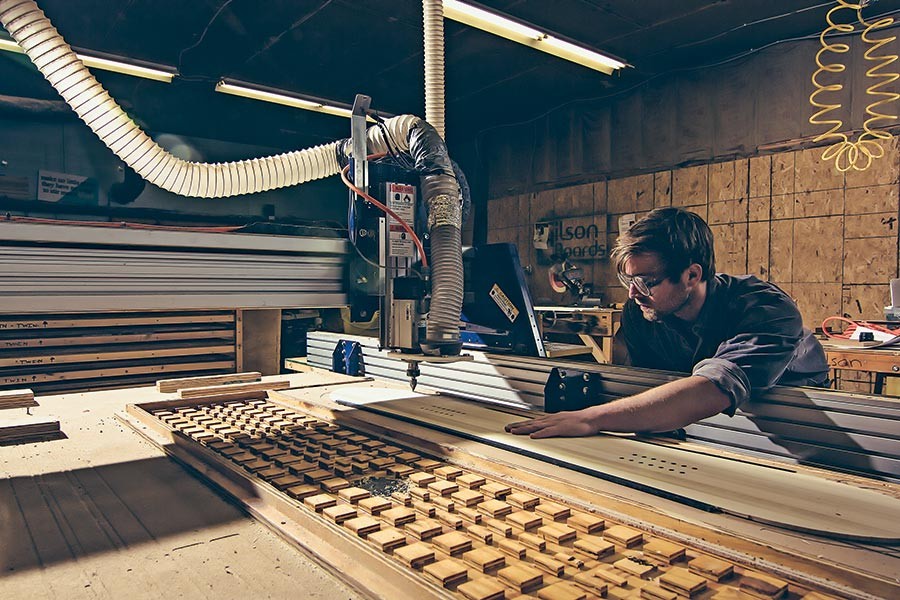As a teenager, Nicholas Gilson, A&S '11, developed a love for board sports—snowboarding, skateboarding, and surfing. And because his father was a hobbyist boat builder with an in-home workshop, young Gilson also developed a love for building his own boards. (He built a surfboard before ever having ridden a wave.) At 14, while helping his father make a catamaran sailboat, Gilson came to wonder whether the principles behind a cat's design—the twin hulls helping the boat slice through the water faster than a single fat hull—might also apply to snowboards, which traditionally have flat bottoms. Today he is CEO of Gilson, which turns out snowboards with catamaran-inspired bottoms and other innovative design features. The company has more than doubled in size every year since its 2013 launch, and the media has taken note: Gilson boards made Wired's "Gear of the Year" list in 2015, and the company was named to Outside magazine's list of the top six boutique American-made ski and snowboard manufacturers.
So, an idea you had in eighth grade has stood the test of time?
I know, right? It was always tempting to think, "Well, obviously, the idea won't work; otherwise the big players would have already done this before."
Did the new design prove itself right away?
God, no. The initial snowboards I built in eighth grade were rudimentary. They were not pressure-molded and were just some fiberglass and plywood I squashed together between two castoff doors. When I took them to the mountains, they didn't really work. But as a kid who had just invested months building them, I convinced myself otherwise.
Did you bring your board-building enthusiasm to Johns Hopkins?
I actually got into a little bit of trouble for building a surfboard in the AMR dorms. You are not supposed to have fiberglass and epoxy on campus.
How did you get back to snowboards?
After Hopkins, I went to teach middle school science in Nashville, Tennessee, with Teach for America. It was a challenge because my kids had such divergent abilities. In one seat, there's a Somali refugee still learning English, and in another seat, a kid asking me advanced math questions. How do you have one lesson plan to reach everyone? Then Austin Royer—the guy I would start the company with—entered the picture as science teacher for grades seven and eight. We decided to develop a collaborative, hands-on learning approach focused on lab projects. And to practice what we preached, I brought in my original prototype snowboard. I told my students that it was what I had been curious about when I was their age and that they should find a project that interests them.
As adult science teachers, you got the board right?
The boards we made were complete garbage. They were replicas of what I had built as a teen but with proper snowboard materials and pressing. During winter break, we took two prototypes out to Colorado and they completely failed—Austin said it was like riding a canoe down the mountain. We were going to quit. Why keep pursuing this failed idea? But back at school, the kids told us we had to keep trying.
We discovered that the geometry wasn't right, and it was creating pressure points. Part of the solution was to create a soft edge—pulling the metal edges of the board back some. This was a totally reactionary design to fix the first failure, but it turns out that the soft edge is what really helps make the board feel so different. On our next mountain trip, we had some riders try them out, and they were excited about the way they drifted in turns. We finally proved that we could change the geometry of a snowboard and have it change the performance.
So you left teaching to form the company?
It wasn't easy. I'm proud of my work as a teacher not because I did so well; I'm proud of my work as a teacher because these students did so well. Science proficiency at the school went from 19 percent to 89 percent during our two years of teaching. But we had this incredibly emotionally charged conversation with the students where they told us we have to go pursue this opportunity. We moved to central Pennsylvania, where Austin's parents had a property that was once a dairy farm. It had a stable, and we shared the space with actual donkeys and lived in a cabin with no electricity. But we also started to build our first real board shop.
Many startups, even those with good ideas, end up failing. What's a key to your success?
Nobody at this company has ever worked for another snowboard company, and the big reason is that we don't want to know how things have always been done. Our pressing system is different from anybody else's in the world and lets us create substantially superior products. It's a trade secret, and all Austin's design. Now, imagine if when we first sat down, we were like, "Hey, how are snowboard presses made?" If someone at the table had worked for another board maker, they may have said, "I'll show you guys," and we never would have created our product.
After your long entrepreneurial journey, how does success feel?
I don't think there's been a moment yet when I felt I could just relax, though the stress has changed. In the early days, the stress was all about product viability. Is this design even possible? Is the market ready for this? Arguably more stressful is to know that it is working and that people appreciate the product. Now, if we fail, it's completely our fault.
Posted in Politics+Society
Tagged snowboarding, entrepreneurship








